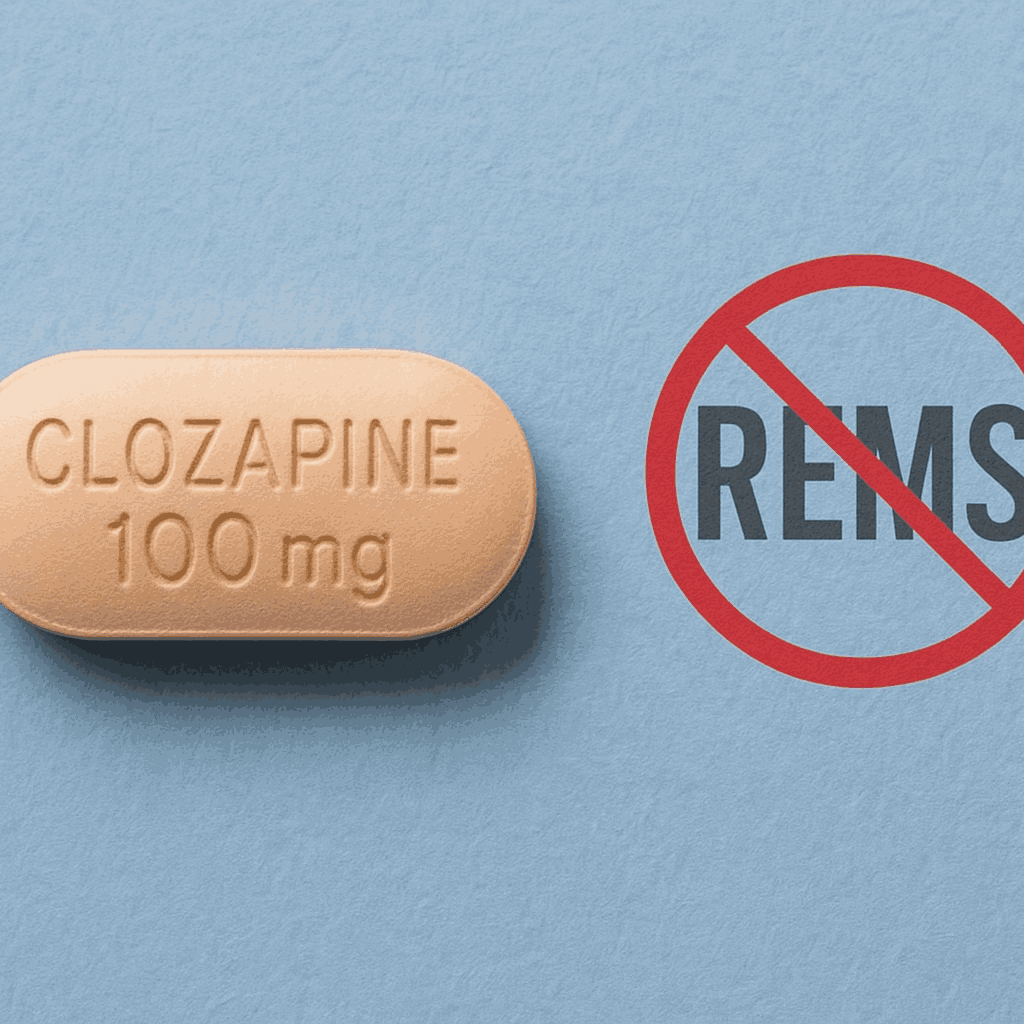Written and Reviewed By: Vikas Londhe, MPharm
In 2024–2025 the FDA concluded that the centralized Clozapine REMS (Risk Evaluation and Mitigation Strategy) is no longer necessary to ensure clozapine’s benefits outweigh the risk of severe neutropenia. As a result the agency removed the REMS requirements, meaning prescribers, pharmacies, and patients are no longer required to enroll in a REMS registry or upload absolute neutrophil count (ANC) results for dispensing. The FDA continues to advise routine ANC monitoring and keeps the boxed warning for severe neutropenia in the product labeling.
What was the Clozapine REMS and why did it exist?
Clozapine has been recognized since its introduction for unique efficacy in treatment-resistant schizophrenia but also for a rare, potentially fatal risk of severe neutropenia (very low neutrophil counts) and agranulocytosis. Starting in the late 1980s and consolidated into shared REMS in 2015, the REMS demanded enrollment of prescribers, pharmacies, and patients and required submission/verification of absolute neutrophil count (ANC) results before dispensing. The REMS centralized monitoring is intended to reduce neutropenia-related harm.
Timeline of the events
November 19, 2024: A joint FDA advisory committee meeting (Drug Safety and Risk Management Advisory Committee together with the Psychopharmacologic Drugs Advisory Committee) reviewed data and advised that the REMS elements requiring documentation/registry reporting were no longer necessary, while emphasizing continued clinical monitoring.
February 24, 2025: FDA publicly stated that it did not expect prescribers, pharmacies, and patients to participate in the Clozapine REMS or to report ANC results to the REMS, and instructed manufacturers to submit labeling modifications. Clinical guidance to continue ANC monitoring remained.
June 13, 2025: FDA indicated the REMS operations were officially eliminated and REMS activity ceased; product labeling revisions and medication guides reflect the updated approach. (FDA pages are updated to reflect the effective date and ongoing content adjustments.)
Why the FDA decided to remove the REMS
The agency used a structured re-evaluation: literature review, adverse event database review, and targeted observational studies in collaboration with academic centers, U.S. Department of Veterans Affairs health system, and FDA Sentinel System. Key points in the FDA are reasoning:
Risk profile understood and still manageable: Severe neutropenia remains a known, serious risk most likely in the first months of treatment but the FDA judged that current prescribing information, boxed warnings, and a new Medication Guide provide adequate risk communication.
Practice and training have changed since 1989: Prescribers’ awareness of neutropenia risk and monitoring practices have improved, and clinical systems now routinely incorporate clozapine safety information.
REMS was creating access barriers: It was emphasized by advisory committee and stakeholder input that the REMS could delay or hinder access to clozapine, sometimes for hours or days, which are particularly significant because clozapine is the only FDA-approved option with consistent benefit for treatment-resistant schizophrenia.
Advisory committee recommendation: The November 2024 advisory committee voted strongly in favor of eliminating the REMS requirement that required documentation/uploading of ANC results. That recommendation heavily influenced FDA’s decision.
What actually changed?
No more REMS enrollment for prescribers, pharmacies, or patients: Pharmacies no longer verify REMS enrollment or require proof of ANC before dispensing. Prescribers do not need to submit ANC results to a centralized REMS system.
Labeling and patient information updated: Severe neutropenia remains in boxed warnings; a new Medication Guide and updated prescribing information explain risks and recommended ANC monitoring schedules.
Monitoring expectations remain: The FDA explicitly recommends ongoing ANC monitoring per the prescribing information; clinical vigilance and early intervention for neutropenia still matter.
Reactions from clinicians, pharmacists, and patient advocates
Professional societies and pharmacy groups widely welcomed the change as a way to reduce administrative burden and improve access. For example, ASHP and other pharmacy bodies praised the move, saying the REMS had been an access barrier. Psychiatrists and advocacy groups noted the change could increase appropriate clozapine use for people who need it. At the same time, editorials and opinions in psychiatry journals emphasized that removal of the REMS does not mean removal of the clinical responsibility to monitor ANC and to promptly manage neutropenia.
Clinical risks and what prescribers should do now
Removing the REMS simplifies documentary obligations but does not change the underlying safety profile of clozapine. Practical, evidence-based steps for clinicians and pharmacists:
Continue ANC monitoring exactly as recommended in the prescribing information: The FDA still recommends following the baseline and follow-up ANC schedule in the label and document results in the patient record.
Counsel patients clearly: Explain the signs and symptoms of neutropenia and when to seek urgent care, provide the Medication Guide and document counseling
Maintain local systems for rapid lab access and result review: The primary harm the REMS wanted to prevent delayed recognition of neutropenia remains avoidable if clinics ensure timely blood draws and prompt, reliable result review.
Report adverse events: Continue to report suspected serious clozapine-related adverse events to FDA MedWatch. Vigilant postmarket reporting helps the agency track rare events.
Coordinate with pharmacies: Although pharmacies no longer require REMS verification, clinicians should confirm that dispensing workflows support rapid access while maintaining safety checks.
For patients and caregivers
You no longer must be enrolled in a REMS registry just to get clozapine. Pharmacies will not require submission of ANC results to REMS.
You should still expect ANC blood tests as part of safe clozapine care. Talk to your prescriber about how often you will have blood tests and what the results mean.
The FDA’s removal of the centralized Clozapine REMS removes regulatory load that had limited the access for some patients. The agency’s decision based on updated evidence, advisory-committee advice, and the view that labeling and routine clinical practices can manage the remaining neutropenia risk. That makes clozapine easier to access, but it places the obligation on health systems and clinicians to keep monitoring and rapid response systems vigorous. If implemented sensibly, this change should improve timely access to a uniquely effective therapy at the same time maintaining patient safety.
References
FDA: “FDA removes risk evaluation and mitigation strategy (REMS) program for the antipsychotic drug Clozapine.” FDA Drug Safety page; content current Aug 27, 2025 https://www.fda.gov/drugs/drug-safety-and-availability/fda-removes-risk-evaluation-and-mitigation-strategy-rems-program-antipsychotic-drug-clozapine#:~:text=FDA%20has%20removed%20the%20REMS,be%20dispensed%20to%20the%20patient.
Frequently Asked Questions | Clozapine REMS Modification, 25 Feb 2025, USFDA, https://www.fda.gov/drugs/postmarket-drug-safety-information-patients-and-providers/frequently-asked-questions-clozapine-rems-modification
FDA Elimates Clozapines REMS Program, ASHP news Centre, 27 February 2025, https://news.ashp.org/news/ashp-news/2025/02/27/fda-eliminates-clozapine-rems-program
FDA Officially Eliminates Clozapine REMS, 16 June 2025, Psychiatry Times, https://www.psychiatrictimes.com/view/fda-officially-eliminates-clozapine-rems
Kelly DL, Kane JM, Love RC, Cotes RO. FDA Eliminates the Clozapine REMS-What Comes Next? JAMA Psychiatry. 2025 Aug 1;82(8):751-752. Doi: 10.1001/jamapsychiatry.2025.1155. PMID: 40465276



